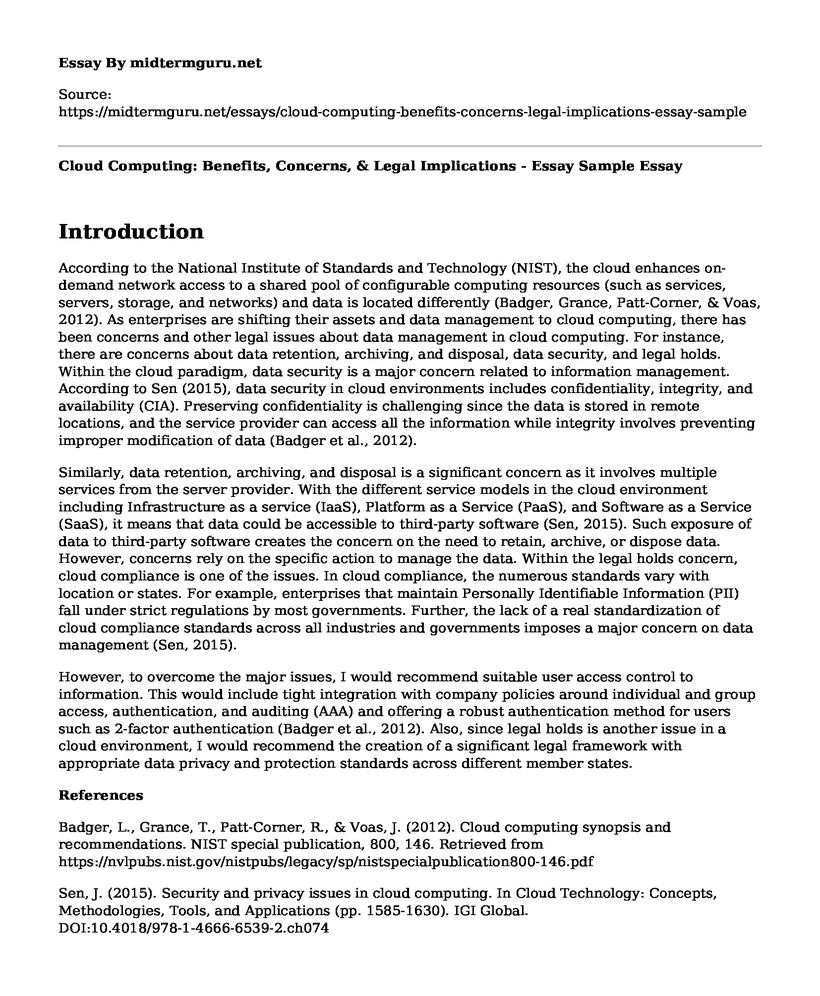Introduction
According to the National Institute of Standards and Technology (NIST), the cloud enhances on-demand network access to a shared pool of configurable computing resources (such as services, servers, storage, and networks) and data is located differently (Badger, Grance, Patt-Corner, & Voas, 2012). As enterprises are shifting their assets and data management to cloud computing, there has been concerns and other legal issues about data management in cloud computing. For instance, there are concerns about data retention, archiving, and disposal, data security, and legal holds. Within the cloud paradigm, data security is a major concern related to information management. According to Sen (2015), data security in cloud environments includes confidentiality, integrity, and availability (CIA). Preserving confidentiality is challenging since the data is stored in remote locations, and the service provider can access all the information while integrity involves preventing improper modification of data (Badger et al., 2012).
Similarly, data retention, archiving, and disposal is a significant concern as it involves multiple services from the server provider. With the different service models in the cloud environment including Infrastructure as a service (IaaS), Platform as a Service (PaaS), and Software as a Service (SaaS), it means that data could be accessible to third-party software (Sen, 2015). Such exposure of data to third-party software creates the concern on the need to retain, archive, or dispose data. However, concerns rely on the specific action to manage the data. Within the legal holds concern, cloud compliance is one of the issues. In cloud compliance, the numerous standards vary with location or states. For example, enterprises that maintain Personally Identifiable Information (PII) fall under strict regulations by most governments. Further, the lack of a real standardization of cloud compliance standards across all industries and governments imposes a major concern on data management (Sen, 2015).
However, to overcome the major issues, I would recommend suitable user access control to information. This would include tight integration with company policies around individual and group access, authentication, and auditing (AAA) and offering a robust authentication method for users such as 2-factor authentication (Badger et al., 2012). Also, since legal holds is another issue in a cloud environment, I would recommend the creation of a significant legal framework with appropriate data privacy and protection standards across different member states.
References
Badger, L., Grance, T., Patt-Corner, R., & Voas, J. (2012). Cloud computing synopsis and recommendations. NIST special publication, 800, 146. Retrieved from https://nvlpubs.nist.gov/nistpubs/legacy/sp/nistspecialpublication800-146.pdf
Sen, J. (2015). Security and privacy issues in cloud computing. In Cloud Technology: Concepts, Methodologies, Tools, and Applications (pp. 1585-1630). IGI Global. DOI:10.4018/978-1-4666-6539-2.ch074
Cite this page
Cloud Computing: Benefits, Concerns, & Legal Implications - Essay Sample. (2023, Feb 06). Retrieved from https://midtermguru.com/essays/cloud-computing-benefits-concerns-legal-implications-essay-sample
If you are the original author of this essay and no longer wish to have it published on the midtermguru.com website, please click below to request its removal:
- Essay Report About Service Company in United Arab Emirates
- Paper Example on Town Planning Legislations
- Research Paper on Cybersecurity
- Application Letter to MSc in Software Engineering
- DHL: A Logistics Giant Driven By Innovation Since 1969 - Research Paper
- Maximising Performance, Speed & Efficiency of MS Access Databases - Essay Sample
- Healthcare Systems: Complexity, Resources & Patient Care - Essay Sample







